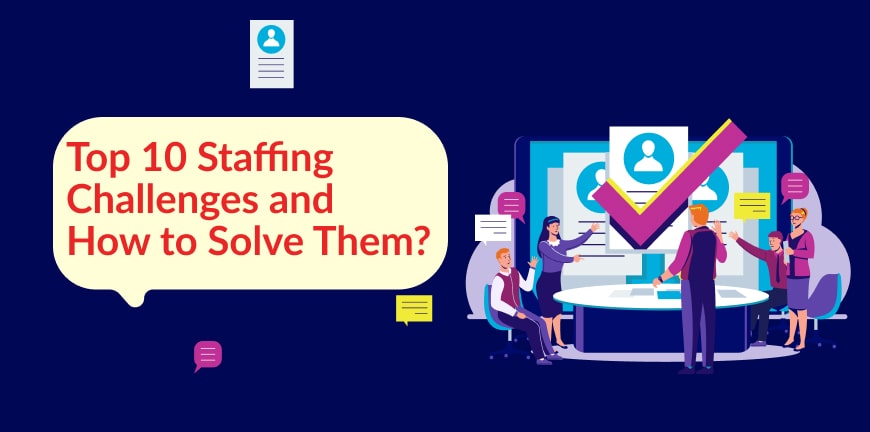
What is Labour Shortage and How to Overcome it?
24/04/2025
What Is Employee Training and Development? Importance, Types & Best Practices
28/04/2025The mantra that companies should follow religiously in this fast-paced, competitive, and evolving business environment is ‘Innovate, adapt, and scale.” Across sectors, be it manufacturing, automotive, tech, or energy, companies are under constant pressure to adopt the mantra, however, it is only possible with the right people in the right place.
Organizations today are struggling with evolving staffing challenges across the globe. From seismic technological advancements and dynamic shifts in skill requirements to changing workforce expectations, the competition for top talent is rising, transforming the recruitment landscape into a more complex space.
Top 10 Staffing Challenges and Their Solutions
1. Talent Acquisition
Businesses every day face the critical challenge of acquiring the right talent. Companies need a way to stay ahead of the curve as the competition is getting fiercer by the day. One of the significant issues driving this talent crunch and staffing issues is the growing skills gap.
Rapid technological advancements are occurring, and the skills required today mostly did not exist a few years back. There is a vast requirement for roles in AI, automation, cybersecurity, electric mobility, and advanced manufacturing. However, the talent pool has not caught up. This has led to businesses struggling to identify candidates who can cater to their evolving technical and soft skill requirements.
Solution
Businesses can focus on investing in employer branding and talent marketing to address the challenge of talent acquisition. They must build a robust employer brand, broaden their talent pool, and offer competitive compensation packages to draw and retain top talent.
Organizations can also expand their talent pool by optimizing job posting sites, social media, and employee referrals. By offering competitive compensation packages like benefits and bonuses, organizations can be more attractive to potential employees.
2. Skills Gap
The rapid evolution of technology has led to a major skills gap in various sectors. The gap is a result of companies grappling to find the right kind of individuals with appropriate skills and qualifications to align with the changing technology and industry trends.
Businesses today are looking for professionals with specialized skills who can work with innovative tools, comprehend complex systems, and assist in navigating the ever-changing industry landscapes. If companies fail to attract such talent, then it can be damaging to organizations as it can lead to long-term talent shortages, jeopardizing growth and innovation.
Solution
Bridging the skills gap must be a priority for organizations across sectors. They can take multiple steps, like investing in training and development programs, enabling employees to learn new skills and comply with the changing technology and industry trends.
They must invest in programs involving upskilling and reskilling for existing employees, collaborate with educational institutions, offer internships and apprenticeships to younger workers, etc. Bridging the skills gap is not just about hiring the right talent, it is about creating a future-ready workforce that can evolve and coexist with technology.
3. Employee Retention
The long-term success of a business largely depends on its ability to retain skilled employees. If individuals are not willing to stay, it is the company that will bear the brunt as they will lose out on the investment made in training and hiring, along with the knowledge, relationships, and continuity those employees bring.
A company’s reputation can be tarnished internally and externally if they have a high turnover, as it will disrupt operations and diminish team morale.
Solution
The key to retaining talented employees is to create a positive company culture, fostering employee engagement, offering training and development opportunities, and providing a competitive compensation package.
Organizations can encourage open communication, offer opportunities for advancement and skill development, acknowledge employee achievement,s and help them build their career in a positive and welcoming work environment.
4. Diversity and Inclusion
One of the most significant staffing industry challenges is the lack of diversity and inclusion in the workplace. This is becoming a growing concern for businesses, and somehow, they are failing to address this issue and therefore risking losing out on skilled and valuable employees while damaging their reputation.
It is especially challenging for traditional industries to promote inclusivity and diversity as they are still not fully aware of the concept.
Solution
Organizations must take initiative-taking steps to hire and retain diverse talent. To facilitate a diverse and inclusive workplace, organizations can invest in ongoing education and awareness initiatives that promote inclusivity across different levels.
They can also engage in outreach efforts like collaborating with community groups and establishing diverse hiring panels to attract a wider range of candidates.
Additionally, they can introduce inclusive practices entailing flexible work options, accessible workplaces, and equitable policies, and enable to help create an environment where employees feel valued and empowered.
5. Workforce Demographics
With the rapidly evolving workforce, and an increase in the number of employees working remotely, or freelancing, it can create staffing problems for employers who grapple to adapt to these changing demographics and are unable to provide the necessary support and resources to remote or part-time workers.
Solution
Thriving in this new landscape is not easy, and to exist in its organizations need to draft clear, structured remote work policies outlining expectations, performance metrics, communication protocols, and available resources. The company should provide remote workers with resources like reliable technology to stay productive and engaged.
6. Pay Package issues
Organizations need to offer competitive salaries and benefits to employees, but it can sometimes be one of the major staffing issues for businesses. While fair compensation is significant, employers must be cautious in balancing these costs with overall profitability.
It can strain the organization’s financial stability if compensation expenses go out of hand. This might lead to budget cuts, layoffs, or downsizing. The key is to strike the right balance and maintain employee satisfaction and long-term business stability.
Solution
Companies must be careful in managing their compensation packages and try out creative approaches like offering flexible work arrangements or non-monetary perks to draw and retain top talent. Additionally, companies can offer benefits like remote work options, professional development opportunities, or wellness programs, enhancing employee satisfaction without significantly increasing costs.
7. Training and Development
One of the current staffing challenges is providing continuous training and development to build and maintain a competitive workforce. A number of companies struggle to allocate sufficient time and resources to these initiatives. The approach might result in gaps in skills and adversely impact productivity and overall business dynamics.
Solution
Organizations should prioritize training and development while considering cost-effective options like online courses, online seminars, and industry conferences to accelerate employee skills.
They should focus on facilitating a culture that gives significance to continuous learning. This will not only enable companies to close skill gaps but also uplift employee engagement and commitment to their roles.
8. Employee Engagement
It is well noticed that employees who are comfortable and engaged in an organization tend to be more productive, motivated, and loyal. However, offering elevated levels of engagement and maintaining them can be challenging for many organizations, especially in remote or hybrid work settings.
Solution
Fostering open communication, providing opportunities for feedback, and offering employee achievements recognition and rewards should be an employer’s focus to create a positive company culture. They should organize regular team-building activities and social events, enabling employees to feel more connected to their colleagues and work environment.
9. Legal Compliance
It can be a huge challenge for businesses to comply with labour laws and regulations, especially for companies operating in multiple states or countries. Companies must stay informed about legal updates and ensure that they adhere to all relevant laws. Failing to maintain compliance can drive a company to pay costly fines, face legal issues, and damage its reputation.
Solution
To ensure legal compliance, companies must be well informed about the changing labour laws and regulations. They must seek guidance from legal experts when needed. Establishing clear policies and procedures, encouraging ethical conduct, and regulatory compliance can help businesses prevent legal issues from occurring.
10. Succession Planning
Succession planning is an approach that entails identifying and preparing employees to accept critical leadership roles when available. Many companies, however, face hurdles in this area, resulting in potential leadership gaps and a dearth of eagerness to navigate future challenges.
Solution
Companies can start identifying key roles and responsibilities and draft a strategy to develop and promote employees to fill these roles. They can invest in leadership development and cross-training programs to help employees prepare for future leadership positions.
It can be a daunting task to navigate the complexities of staffing challenges in 2025, along with talent management. However, with a clear perspective of the key issues and the practical strategies, you can proactively address these difficulties and foster a robust, high-performing workforce.
The success of an organization depends upon how it can create a supportive, engaging work environment, embracing technology at the same time remain flexible during times of evolving talent trends. By regularly reviewing the staffing approach and being initiative-taking to stay ahead of the game, businesses can position themselves for long-term success and excellence.
➣➣ Also Read: Top 10 Healthcare Staffing Challenges and Their Solutions
Contact Us For Business Enquiry

Kasthuri R
Kasthuri R is the Co-Founder & Executive Director at ALP Consulting, bringing over 23 years of experience in search, staffing, and HR consulting. She has been instrumental in driving ALP’s recruitment, employee leasing, and executive search practices across diverse industry verticals. With deep expertise in talent acquisition, HR strategy, and operational management, Kasthuri has built scalable, client-focused solutions that enhance workforce efficiency. Her strategic leadership continues to steer ALP Consulting toward innovation and excellence in people management.




